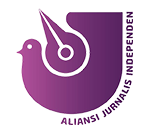Disaster Journalism and Media Responsibility: Coverage of Flood Disasters in Lampung
Abstract
Local media in Lampung demonstrated varied disaster journalism implementation during the 2024 flood coverage. Despite possessing strengths in early warning systems and ethical reporting, weaknesses persisted: coverage limited to chronological events without in-depth analysis, inadequate preparedness of educational content, and weak post-disaster rehabilitation reporting. This study examines the implementation of disaster journalism principles in flood coverage by three major Lampung online media outlets: Lampungpost.co, Radarlampung.co.id, and Tribunlampung.co.id during 2024. Using a qualitative descriptive approach with a social responsibility theory framework, data were collected through content analysis of 72 news articles regarding flood (January to May 2024), in-depth interviews with editors-in-chief and coverage managers, and document review of coverage processes. The findings reveal suboptimal disaster journalism implementation across all disaster phases. The pre-disaster phase lacked comprehensive educational content. During disasters, though ethical standards were maintained, focus remained limited to chronological events. The post-disaster phase showed significant weaknesses in rehabilitation coverage and government accountability. The absence of specialized disaster journalism training emerged as a critical limiting factor. The study recommends specialist training programs, collaborative frameworks between media and disaster management agencies, and comprehensive coverage guidelines.
Keywords
Full Text:
PDFReferences
Alfarabi, A., & Adhrianti, L. (2021). Bencana, informasi dan komunikasi serta keterlibatan media massa lokal dalam managemen bencana: Studi pendekatan jurnalisme bencana di Provinsi Bengkulu. Jurnal Ilmu Komunikasi, 10(1), 29–38.
Antunes, M. N., Pereira, S. da S., Zêzere, J. L., & Oliveir, A. E. (2022). Disaster journalism in print media: analysis of the top 10 hydrogeomorphological disaster events in Portugal. International Journal of Disaster Risk Science, 13, 521–535. https://doi.org/10.1007/s13753-022-00425-2
Aryal, D. R. (2022). Issues relating disaster to journalism education. Nepal Journals Online, 2(1), 1–8. https://doi.org/10.3126/cj.v2i1.57007
Brüggemann, M., Frech, J., & Schäfer, T. (2022). Transformative journalisms. In The Routledge Handbook of Environment and Communication (2nd ed.). Routledge. https://doi.org/10.4324/9781003119234-17
Denzin, N. K., & Lincoln, Y. S. (2024). The sage handbook of qualitative research (5th ed.). SAGE Publications.
Englund, L., Johannesson, K. B., & Arnberg, F. K. (2022). Media perception and trust among disaster survivors: Tsunami survivors’ interaction with journalists, media exposure, and associations with trust in media and authorities. Frontiers in Public Health, 10, 943444. https://doi.org/10.3389/fpubh.2022.943444
Englund, L., Johannesson, K. B., & Arnberg, F. K. (2023). Reporting under extreme conditions: journalists’ experience of disaster coverage. Frontiers in Communication, 8, 1060169. https://doi.org/10.3389/fcomm.2023.1060169
Fitriawan, R. A. (2017). Jurnalisme sains dan sistem peringatan dini di Indonesia. Kajian Jurnalisme, 1(1), 39–57. https://doi.org/10.24198/jkj.v1i1.12225
Haulan, I. (2024). Ini sederet penyebab Bandar Lampung rawan banjir. Lampost.Co. https://lampost.co/lampung/ini-sederet-penyebab-bandar-lampung-rawan-banjir/
Houston, J. B., Schraedley, M. K., Worley, M. E., Reed, K., & Saidi, J. (2019). Disaster journalism: Fostering citizen and community disaster mitigation, preparedness, response, recovery, and resilience across the disaster cycle. Disasters, 43(3), 591–611. https://doi.org/10.1111/disa.12352
Joye, S. (2023). McQuail, D. & Deuze, M. (2020). McQuail’s Media & Mass Communication Theory (seventh edition). London: SAGE. 672 pp. Communications, 48(2), 342–343. https://doi.org/10.1515/commun-2021-0094
Khan, R. E., Limpot, K. B., & Villanueva, G. N. (2020). Social responsibility theory of the press and its effect on framing tv news about children. Journal of Media Ethics, 35(3), 152–163. https://doi.org/10.1080/23736992.2020.1779594
Kovach, B., & Rosenstiel, T. (2021). The elements of journalism, revised and updated 4th edition: What newspeople should know and the public should expect. Crown.
Li, W., Zhu, J., Pirasteh, S., Zhu, Q., Fu, L., Wu, J., Hu, Y., & Dehbi, Y. (2022). Investigations of disaster information representation from a geospatial perspective: Progress, challenges and recommendations. Transactions in GIS, 26(3), 1376–1398. https://doi.org/10.1111/tgis.12922
Lovari, A., & Bowen, S. A. (2019). Social media in disaster communication: A case study of strategies, barriers, and ethical implications. Journal of Public Affairs, 20(1), 1967. https://doi.org/10.1002/pa.1967
Matthews, J., & Thorsen, E. (2022). Theorising disaster communities: Global dimensions and their local contexts. The Journal of International Communication, 28(2), 228–248. https://doi.org/10.1080/13216597.2022.2098164
Mishra, H. S. (2023). An ethical code for disaster journalism. In A. Singh (Ed.), International Handbook of Disaster Research. Springer. https://doi.org/10.1007/978-981-19-8388-7_85
Molla, N. A., Sangsanont, J., Thayanukul, P., & Furumai, H. (2016). Proper dissemination of information to improve people awareness on flood disaster: A case study of 2011 flood in Thailand. Applied Environmental Research, 38(2), 1–12. https://digital.car.chula.ac.th/aer/vol38/iss2/1/
Muhammed, S. T., & Mathew, S. K. (2022). The disaster of misinformation: A review of research in social media. International Journal of Data Science and Analytics, 13(4), 271–285. https://doi.org/10.1007/s41060-022-00311-6
Na, L. (2021). Book review: Media, journalism and disaster communities. New Media & Society, 23(6), 1728–1731. https://doi.org/10.1177/14614448219920
Nasution, N. A. (2025). Transformasi jurnalisme digital dan adopsi AI di media lokal. Intercode: Jurnal Ilmu Komunikasi, 5(1), 1–11. https://doi.org/10.36269/ire.v5i1.3083
Nugraheni, I. L., Suyatna, A., Setiawan, A., & Abdurrahman. (2022). Flood disaster mitigation modeling through participation community based on the land conversion and disaster resilience. Heliyon, 8(8), 09889. https://doi.org/10.1016/j.heliyon.2022.e09889
Nusantara, S. B., Rinaldi, I., & Veronika, V. (2024). Stopping the virus: Study on participatory journalism and digital humanitarian during a non-natural disaster in Indonesia. Kajian Jurnalisme, 7(2), 140–157. https://doi.org/10.24198/jkj.v7i2.50101
Panuju, R. (2018). Etika jurnalistik dan jurnalisme bencana pada pemberitaan Gunung Agung di portal berita Balipost.com. Jurnal Ilmu Komunikasi, 15(2), 219–232. https://doi.org/10.24002/jik.v15i2.1455
Perreault, M. F. (2021). Journalism beyond the command post: Local journalists as strategic citizen stakeholders in natural disaster recovery. Journalism Studies, 22(10), 1279–1297. https://doi.org/0.1080/1461670X.2021.1950565
Pinto, J., Myrick, J. G., & Xie, L. (2022). Constructing hurricane Florence’s flooding: comparing local and national news. Journalism Practice, 16(6), 1057–1077. https://doi.org/10.1080/17512786.2020.1832905
Prawira, I., & Mahamed, M. (2024). Citizen journalism under pressure: The case of Indonesia, Malaysia and the Philippines. Journalism, 26(5), 1103–1121. https://doi.org/10.1177/146488492412692
Rasyid, E., Saharuddin, E., & Rohmadani, Z. V. (2024). Disaster reporting in Indonesian national online media: Agenda setting and sentiment analysis. Jurnal Komunikasi Indonesia, 13(2), 4. https://doi.org/10.7454/jkmi.v13i2.1241
Rezaldi, Y., Kadir, R., Ijab, M. T., & Ahmad, A. (2020). Disaster information media in ASEAN countries: A paired comparison method. Jurnal Komunikasi: Malaysian Journal of Communication, 36(1), 334–355. https://ejournal.ukm.my/mjc/article/view/27629
Su, C. (2020). Feeling the catastrophe: The interplay between emotional story-telling and journalistic authority in the televisual construction of natural disasters. Asian Journal of Communication, 30(5), 363–385. https://doi.org/10.1080/01292986.2020.1813182
Sukmono, F. G., & Junaedi, F. (2018). Jurnalisme sensitif bencana dalam manajemen pencarian, pengelolaan informasi dan pemberitaan bencana di ruang redaksi. Jurnal ASPIKOM, 3(4), 712–721. https://doi.org/10.24329/aspikom.v3i4.185
Tandoc, E. C., & Takahashi, B. (2016). Journalists are humans, too: A phenomenology of covering the strongest storm on earth. Journalism, 19(7), 917–933. https://doi.org/10.1177/1464884916657518
United Nations Office for Disaster Risk Reduction (UNDRR). (2015). Sendai framework for disaster risk reduction 2015–2030. United Nations. https://www.undrr.org/media/16176/download?startDownload=20250729
Velivela, V., Raj, C., Tiwana, M. S., Prasanna, R., Samarawickrama, M., & Prasad, M. (2022). The effectiveness of social media engagement strategy on disaster fundraising. Proceedings of the International ISCRAM Conference. https://doi.org/10.48550/arXiv.2210.11322
Wahyudi, D., & Sujoko, A. (2024). The ethical experience of online journalists in avoiding trial by the press. Kajian Jurnalisme, 7(2), 189–203. https://doi.org/10.24198/jkj.v7i2.49863
Wahyuni, H. I., Rum, M., Octastefani, T., & Fitrah, A. A. (2022). Between science, religion, and politics: multi-layered communication responses to maritime disaster in Indonesia. Media Asia, 50(3), 355–372. https://doi.org/10.1080/01296612.2022.2153462
DOI: https://doi.org/10.24198/jkj.v9i1.62439
Refbacks
- There are currently no refbacks.
Copyright (c) 2025 The Author(s)

This work is licensed under a Creative Commons Attribution-NonCommercial-ShareAlike 4.0 International License.
Kajian Jurnalisme Indexed by:
Editorial Office of Kajian Jurnalisme:
Journalism Study Program, Faculty of Communication Sciences, Universitas Padjadjaran
Building 3 2nd Floor, Jl. Raya Bandung Sumedang KM.21, Jatinangor, Sumedang Regency, West Java 45363
Email: kajian.jurnalisme.fikom@unpad.ac.id
Telepon: (022) 7796954
Faks: (022) 7794122
Kajian Jurnalisme Supervised by:













